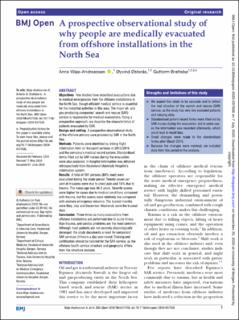| dc.contributor.author | Waje-Andreassen, Anne | |
| dc.contributor.author | Østerås, Øyvind | |
| dc.contributor.author | Brattebø, Guttorm | |
| dc.date.accessioned | 2021-05-03T12:34:06Z | |
| dc.date.available | 2021-05-03T12:34:06Z | |
| dc.date.created | 2020-11-09T09:09:22Z | |
| dc.date.issued | 2020 | |
| dc.identifier.issn | 2044-6055 | |
| dc.identifier.uri | https://hdl.handle.net/11250/2753291 | |
| dc.description.abstract | Objectives Few studies have described evacuations due to medical emergencies from the offshore installations in the North Sea, though efficient medical service is essential for the industrial activities in this area. The major oil- and gas-producing companies’ search and rescue (SAR) service is responsible for medical evacuations. Using a prospective approach, we describe the characteristics of patients evacuated by SAR.
Design and setting A prospective observational study of the offshore primary care provided by SAR in the North Sea.
Methods Patients were identified by linking flight information from air transport services in 2015/2016 and the company’s medical record system. Standardised forms filled out by SAR nurses during the evacuation were also analysed. In-hospital information was obtained retrospectively from Haukeland University Hospital’s information system.
Results A total of 381 persons (88% men) were evacuated during the study period. Twenty-seven per cent of missions were due to chest pain and 18% due to trauma. The mean age was 46.0 years. Severity scores were higher for cases due to medical conditions compared with trauma, but the scores were relatively low compared with onshore emergency missions. The busiest months were May, July and December. Weekends were the busiest days.
Conclusion Three times as many evacuations from offshore installations are performed due to acute illness than trauma, and cardiac problems are the most common. Although most patients are not severely physiologically deranged, the study documents a need for competent SAR services 24 hours a day year-round. Training and certification should be tailored for the SAR service, as the offshore health service structure and geography differs from the structure onshore. | en_US |
| dc.language.iso | eng | en_US |
| dc.publisher | BMJ | en_US |
| dc.rights | Navngivelse-Ikkekommersiell 4.0 Internasjonal | * |
| dc.rights.uri | http://creativecommons.org/licenses/by-nc/4.0/deed.no | * |
| dc.title | A prospective observational study of why people are medically evacuated from offshore installations in the North Sea | en_US |
| dc.type | Journal article | en_US |
| dc.type | Peer reviewed | en_US |
| dc.description.version | publishedVersion | en_US |
| dc.rights.holder | Copyright 2020 The Authors | en_US |
| dc.source.articlenumber | e037558 | en_US |
| cristin.ispublished | true | |
| cristin.fulltext | original | |
| cristin.qualitycode | 1 | |
| dc.identifier.doi | 10.1136/bmjopen-2020-037558 | |
| dc.identifier.cristin | 1845995 | |
| dc.source.journal | BMJ Open | en_US |
| dc.identifier.citation | BMJ Open. 2020, 10:e037558 | en_US |
| dc.source.volume | 10 | en_US |

